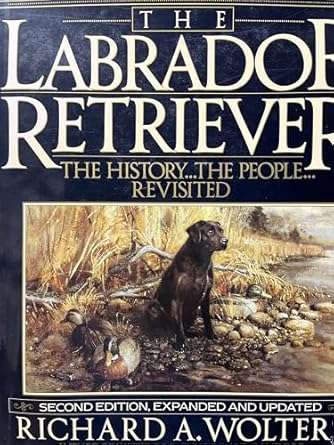This “The Fascinating History and Origin of the Labrador Retriever” post may contain affiliate links, which means I’ll receive a commission if you purchase through my link, at NO EXTRA COST TO YOU
The Fascinating History and Origin of the Labrador Retriever
The Labrador Retriever is one of the most popular dog breeds in the world. Known for its friendly nature, intelligence, and versatility, the breed has captured the hearts of dog lovers worldwide. However, behind its lovable personality lies a rich and fascinating history. The Labrador Retriever’s journey from working dog to family companion is a story that spans centuries, shaped by various influences and geographic regions. In this blog, we’ll explore the origins of the Labrador Retriever, its development over time, and the factors that led to its global popularity.

The Early Beginnings: Newfoundland, Canada
The Labrador Retriever’s roots trace back to the early 19th century in Newfoundland, Canada. The breed was originally known as the St. John’s dog or Lesser Newfoundland, and it played a vital role in assisting fishermen with their daily tasks. The early Labradors were not the same as the breed we recognize today. They were smaller, hardworking dogs, highly skilled in retrieving fish from the water. Their excellent swimming abilities and stamina made them indispensable to fishermen.
The original St. John’s dogs were the result of crossbreeding between local dogs and imported breeds, including the Newfoundland dog, which is much larger, and the now-extinct English Water Spaniel. This combination of genes gave the St. John’s dogs their remarkable swimming ability, excellent retrieving skills, and sturdy, muscular builds. They were also known for their keen noses, which allowed them to assist in various tasks, including pulling nets and retrieving game from the water.
The Transition to the Labrador Retriever
In the early 19th century, the St. John’s dog began to gain attention outside of Newfoundland. British noblemen and hunters discovered the breed’s exceptional skills, particularly its retrieving abilities. The breed was brought to England, where it began to undergo further refinement.
In England, the St. John’s dog was crossbred with other breeds, including the now-extinct English Pointer, the Bloodhound, and various retrievers. These new crosses led to the development of the modern Labrador Retriever. The breed’s ability to retrieve both on land and in water became even more refined. By the mid-1800s, the Labrador Retriever, as we know it today, began to take shape.
The Role of Labradors in the Sporting World
The Labrador Retriever’s popularity grew rapidly in England, particularly within the realm of hunting and sporting dogs. The breed’s friendly temperament, intelligence, and strong retrieving instincts made it a preferred choice for hunters. Its natural ability to work alongside humans, combined with its eagerness to please, made it an ideal companion in the field.
Labradors excelled at retrieving game from both land and water, making them indispensable to hunters. Their soft mouths, which allowed them to retrieve game without damaging it, set them apart from other dogs in the sporting world. These traits, along with their ability to work tirelessly, helped cement the Labrador’s place in the hunting world.
Recognition of the Labrador Retriever
In the early 1900s, the Labrador Retriever began to gain formal recognition as a distinct breed. The Kennel Club in England officially recognized the breed in 1903. The American Kennel Club (AKC) followed suit, granting recognition to the Labrador Retriever in 1917.
Once the breed was officially recognized, its popularity grew exponentially. Labradors became not only working dogs but also family companions, thanks to their friendly, patient, and playful nature. They quickly gained recognition as the go-to breed for families, service dogs, and therapy dogs due to their gentle disposition and trainability.
Labradors in the Modern Day
Today, the Labrador Retriever remains one of the most beloved and popular breeds in the world. In the United States, Labradors have consistently ranked as the top breed for several decades. Their versatility, loyalty, and gentle nature make them suitable for a variety of roles, from family pets to search and rescue dogs, guide dogs for the blind, and detection dogs.
While the breed has evolved over time, it still retains many of the characteristics that made it valuable to fishermen and hunters in its early days. The Labrador Retriever’s love of water, natural retrieving instinct, and friendly nature are just as strong today as they were centuries ago. Their intelligence and desire to please make them ideal for many roles, from service dogs to competition dogs in obedience and field trials.
The Influence of the Labrador’s History on Its Temperament
The Labrador Retriever’s history as a working dog has had a significant influence on its temperament. Labradors are known for their high energy, intelligence, and trainability. These traits are a direct result of their past as hunting and retrieving dogs. They have a strong drive to work and please their owners, making them highly trainable and eager to learn new tasks.
Labradors are also known for their friendly and social nature. Their early role as working dogs alongside humans has contributed to their affectionate disposition. They thrive on human interaction and enjoy being part of the family. This makes them excellent companions for children and adults alike.
Conclusion
The history and origin of the Labrador Retriever are deeply rooted in its early role as a working dog in Newfoundland, Canada. Over the centuries, the breed has evolved through crossbreeding and selective breeding to become the beloved Labrador Retriever we know today. The Labrador’s friendly nature, intelligence, and strong work ethic make it a breed that excels in many roles, from hunting and sporting to being a family companion and service dog.
The Labrador Retriever’s history is a testament to the breed’s versatility and enduring popularity. Today, it remains one of the most recognized and adored dog breeds in the world. Whether retrieving game in the field, assisting individuals with disabilities, or simply being a loyal and loving family member, the Labrador Retriever continues to make a profound impact in the lives of its owners.

As dog owners, we love to see our furry friends enjoy mealtime. However, watching them gulp down their food in seconds can be alarming. Rapid eating not only poses a choking hazard but can also lead to serious health issues, including bloating and digestive problems. Fortunately, slow feed bowls provide a simple and effective solution to promote healthier eating habits.





